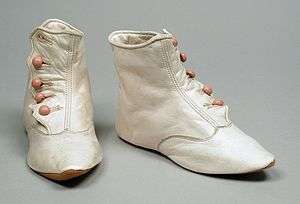Kidskin

Kidskin or kid leather is a type of soft, thin leather that is traditionally used for gloves (hence the phrase 'kid gloves,' used since at least 1888 as a metaphor for careful handling).[1] It is widely used for other fashion purposes such as footwear and clothing. Kidskin is traditionally made from goatskin - more specifically, the skin of young goats (or 'kids'), although equivalent leathers such as lambskin and chickenskin (actually a form of calfskin) give the same effect.[2]
Usage
Kid leather is, and has been used for a number of purposes other than gloves and footwear. Early flexible hair rollers were sometimes made from kidskin, giving a very tight curl.[3]
Papermaking
While vellum is often made using calfskin, kidskin can also be used and in some cases, was preferred. David Laurent de Lara, describing himself as illuminating artist to Queen Victoria, favoured Italian kid vellum for his work.[4]
A form of early medieval parchment, called carta lustra, acting as tracing paper was made using kidskin.[5]
Dolls
Kid was particularly widely used in doll-making during the nineteenth and early twentieth century as a popular material for both French and German doll bodies, particularly fashion dolls.[6][7]
Musical instruments
Kid-leather is often used in the construction of musical instruments such as the bag of the tsampouna, a form of Greek bagpipes.[8] It was also an option for drumheads such as those on tambourines,[9] and specifically, on the Bulgarian daire.[10]
Industrial uses
The Dalén light, used in lighthouses, uses a paraffin-wax saturated kidskin diaphragm in its construction.[11]
Types
In 1916 it was noted that there were over sixty types of goatskin, distinguished by the tanning and finishing processes used.[12] Some of these types are:
- Bronze kid - Cochineal-dyed for a bronzed finish.[12]
- Cadet kid[12]
- Cheveril - A very flexible kid leather used in the late 16th and early 17th centuries.[13]
- Diphera - Mid-19th century type of fine kid used for bonnets.[14][15]
- Dongola - Skin from the sheep, kangaroo or goat.[16]
- French kid - A high quality kidskin.[17]
- Glacé (or glazed) kid - Extremely glossy, shiny finish, often made in more readily available sheepskin, although true kidskin makes better quality glacé kid.[18]
- Gold (or silver) kid - Kidskin gilded for a metallic finish.[19]
- Kangaroo kid - Kidskin finished to emulate kangaroo leather.[12]
- Mat kid - Beeswax and olive-oil treated kidskin with a dull, soft matte finish.[12][20]
- Morocco[12]
- Patent kid - japanned leather.[12]
- Pebbled[12]
- Royal kid[12]
- Suede kid - Kidskin with a suede finish.[21]
- Vici kid - A trademark for high quality chrome-tanned kidskin with a soap and oil finish, developed by Robert Foederer in Philadelphia in the mid-1880s.[12]
References
- ↑ Victor, Terry; Dalzell, Tom (2007). The Concise New Partridge Dictionary of Slang and Unconventional English. Routledge. p. 381. ISBN 1134615345.
- ↑ Cumming, Valerie (1982). Gloves (Reprinted. ed.). London: Batsford. ISBN 9780713410082.
- ↑ Suga, Yusuke; Penney, Alexandra (1980). Beautiful hair by Suga (1st ed.). New York: Random House. pp. 50–52. ISBN 9780394507507.
- ↑ Laurent de Lara, David (1860). Elementary instruction in the art of illumination and missal painting on vellum. London: Longman, Green, Longman and Roberts. p. 60.
- ↑ de Hamel, Christopher (2001). The British Library guide to manuscript illumination : history and techniques. Toronto: British Library. p. 62. ISBN 9780802081735.
- ↑ Herlocher, Dawn (2008). Collectible Dolls. Krause Publications. p. 110. ISBN 9781440219214.
- ↑ A Child's World of Long Ago. Hudson River Museum. 1975. pp. 3–4.
- ↑ Lomax Wood, Anna (2012). "Kalymnian Tsambóuna and Song Repertoire in the Family of Nikitas Tsimouris". In Bucuvalas, Tina. The Florida folklife reader. Jackson: University Press of Mississippi. p. 99. ISBN 9781617031403.
- ↑ Nicholson, William (1821). American Edition of the British Encyclopedia: Or, Dictionary of Arts and Sciences ; Comprising an Accurate and Popular View of the Present Improved State of Human Knowledge, Volume 8. Mitchell, Ames and White. p. 261.
- ↑ Buchanan, Donna A. (2006). Performing democracy : Bulgarian music and musicians in transition. Chicago, Ill. [u.a.]: Univ. of Chicago Press. p. 482. ISBN 9780226078267.
- ↑ Renton, Alan (2000). Lost sounds. Latheronwheel: Whittles. p. 10. ISBN 9781870325837.
- 1 2 3 4 5 6 7 8 9 10 Allen, Frederick J. (1916). The Shoe Industry. Рипол Классик. pp. 96–97. ISBN 9785874447977.
- ↑ Lewandowski, Elizabeth J. (2011). The complete costume dictionary. Lanham, Md.: Scarecrow Press, Inc. p. 62. ISBN 9780810877856.
- ↑ Cumming, Valerie; Cunnington, C. Willett; Cunnington, Phillis (2010). The dictionary of fashion history (New ed.). Oxford [u.a.]: Berg. p. 243. ISBN 9781847885333.
- ↑ Lewandowski, Elizabeth J. (2011). The complete costume dictionary. Lanham, Md.: Scarecrow Press, Inc. p. 88. ISBN 9780810877856.
- ↑ Lewandowski, Elizabeth J. (2011). The complete costume dictionary. Lanham, Md.: Scarecrow Press, Inc. p. 89. ISBN 9780810877856.
- ↑ Lewandowski, Elizabeth J. (2011). The complete costume dictionary. Lanham, Md.: Scarecrow Press, Inc. p. 112. ISBN 9780810877856.
- ↑ Garner Bennett, Hugh (1981). Animal Proteins. Library of Alexandria. pp. 156–157. ISBN 9781465562722.
- ↑ Lewandowski, Elizabeth J. (2011). The complete costume dictionary. Lanham, Md.: Scarecrow Press, Inc. p. 122. ISBN 9780810877856.
- ↑ Lewandowski, Elizabeth J. (2011). The complete costume dictionary. Lanham, Md.: Scarecrow Press, Inc. p. 188. ISBN 9780810877856.
- ↑ Lewandowski, Elizabeth J. (2011). The complete costume dictionary. Lanham, Md.: Scarecrow Press, Inc. p. 281. ISBN 9780810877856.
